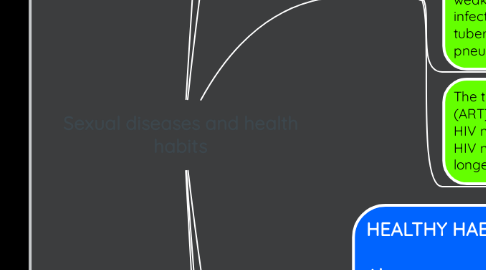Sexual diseases and health habits
by Arantxuki 11

1. Chlamydia
1.1. Caused by the bacterium Chlamydia trachomatis. The disease is spread by oral, vaginal, or anal sex.
1.2. Symptoms can appear in both men and women, including: pain or burning while peeing or during sex, lower belly pain, abnormal vaginal discharge, bleeding between periods, pus or a watery/milky discharge from the penis, swollen or tender testicles, pain, discharge or bleeding around the anus. In women can lead to serious consequences including pelvic inflammatory disease, tubal factor infertility, ectopic pregnancy, and chronic pelvic pain. Lymphogranuloma venereum, another type of STD caused by different serovars of the same bacterium.
1.3. Oral antibiotics, a single dose of azithromycin is one of the most common treatments and is the same one that is used for people with or without HIV. With treatment, the infection should clear up in about a week.
2. Gonorrhea
2.1. Caused by the bacterium Neisseria gonorrhoeae. The gonorrhea bacteria are most often passed from one person to another during sexual contact, including oral, anal or vaginal intercourse.
2.2. Some people may never develop symptoms, but the most common are: the need to urinate more frequently, sore throat, discharge from the vagina or penis, pain while urinating, in sexual intercourse or in the testicles. Untreated infection of gonorrhea in women may ascend up the female reproductive tract and involve the uterus, fallopian tubes, and ovaries, causing a pelvic inflammatory disease. Women may also develop blocking or scarring of the fallopian tubes, which can prevent future pregnancy or cause ectopic pregnancy. Gonorrhea may pass to a newborn infant during delivery.
2.3. Modern antibiotics can cure almost every gonorrhea infections. Most states also provide free diagnosis and treatment at state-sponsored health clinics.
3. AIDS
3.1. Caused by the human immunodeficiency virus (HIV). It is transmitted by contact with infected blood, semen, vaginal and rectal fluids, or from mother to child during pregnancy, childbirth or breast-feeding.
3.2. Some of its symptoms would be: fever, headache, muscle aches and joint pain, sore throat and painful mouth sores, swollen lymph glands, mainly on the neck, diarrhea, weight loss, cough and fatigue. Sometimes you develop a flu-like illness so you might not even notice that you have HIV. HIV attacks on your immune system severely weakening it, increasing the risk of contracting infections such as colds, influenza, pneumonia, tuberculosis and a disease called pneumocystis carinii pneumonia.
3.3. The treatment for HIV is called antiretroviral therapy (ART), this therapy involves taking a combination of HIV medicines every day, ART can't cure HIV, but HIV medicines help people with this disease live longer.
4. Genital herpes
4.1. The viruses get into your body through your mucous membranes. Your mucous membranes are the thin layers of tissue that line the openings of your body. They can be found in your nose, mouth, and genitals. Infected people’s bodily fluids, including: saliva, semen and vaginal secretions.
4.2. Some symptoms and consequences are: blisters may appear in the mouth, lips, face, penis, scrotum, vagina, anus or buttocks, the appearance of blisters is known as an outbreak, and they may become ulcerated. The infected site often starts to itch, and a crust may appear over the sores.
4.3. Three major drugs commonly used to treat it: acyclovir (Zovirax), famciclovir (Famvir), and valacyclovir (Valtrex). These are all taken in pill form. Severe cases may be treated with the intravenous (IV) drug acyclovir.
5. Siphilis
5.1. The cause of syphilis is a bacterium called Treponema pallidum. The most common route of transmission is through contact with an infected person's sore during sexual activity.
5.2. Some symptoms and consequences could be: body rashes on the palms of your hands and the soles of your feet, mild fever, fatigue, sore throat, hair loss, weight loss, swollen glands, headache, and muscle pains.
5.3. It is easy to cure, the most common treatment at all stages is penicillin, an antibiotic medication that can kill the organism that causes syphilis.
6. Papillomaviruses (HPV)
6.1. HPV is a virus that is passed skin-to-skin through sexual intercourse or other forms of skin-to-skin contact of the genitals.
6.2. HPV may not cause symptoms at once, but they can appear years later, HPV viruses can lead to genital warts and cancer.
6.3. There is no treatment for the virus, but the symptoms can be treated (prevention through the HPV vaccine).
7. HEALTHY HABITS: Always use a condom while having sex to prevent sexually transmitted diseases and avoid unwanted pregnancy. Avoid sharing towels or underclothing. Wash before and after intercourse. Get a vaccination for papillomaviruses. Get tested for HIV.


